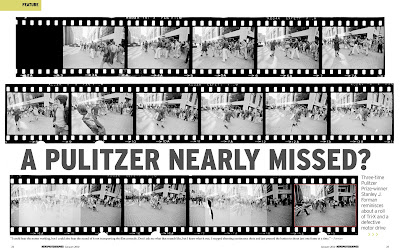Anti-busing proponent and City Counselor, Louise Day Hicks, had hosted a group of students in the Chambers for a salute to the flag, served with cookies and milk. Pouring onto the Plaza steps after the reception, this group of demonstrators confronted a second group of students invited to tour the Hall. Tempers flared and some shoving began.
I had a 135mm lens and motor drive on one camera and a 35mm on the other. As the shuffling began I switched my 35 mm lens to a 20 mm. Over my shoulder I saw a Black man (later identified as Ted Landsmark) approach the Plaza from Washington and State and immediately thought he would be a target.
I felt like I was watching a Clint Eastwood movie, witnessing the slow-motion moment when the gauntlet is tossed before igniting the outbreak of violence. I started taking photos with the 20 mm lens. Detecting a sound I realized the motor wasn’t transporting film. I stopped shooting continuous shots and pressed the button for one frame at a time.
The victim, Ted Landsmark, was transported to the Mass General Hospital. The crowd worked it’s way to the Federal Court House in Post Office Square. Once there I was told to run my shots into the Herald by reporter, Joe Driscoll. I did not grasp the magnitude of what I captured until later that day.
AP and the Globe had tried to cover it from a bad angle and before the real action began. I had the best shots. The demonstration had come to me. I took my chances and developed my film in the unreliable Kodak Versamat at the office, known to shred film like a pasta-maker. It developed just the way it should have.
The editors were very frightened by the series of images captured on my contact sheet. It was a volatile situation, it was busing, and this was Boston. As fate would have it, Howard Hughes had died that day. Appeased by sharing front-page space with other big news, they no longer feared showing the racism that rang out that day on the top of page one.
We were the first paper in Boston to get motor drives and the whole staff got one Nikon F with a motor drive and 4 lenses: 20, 35, 135 and 200. We had community lens in the locker for longer telephotos. I bought my own second Nikon F camera. I was always prepared and I got my shot.
Working with Digital Silver Imaging I have reprinted the original contact sheet. It allows me to show the full impact of the photo series. The full story did not run then but can be viewed in new light today. For prints contact www.digitalsilverimaging.com.

